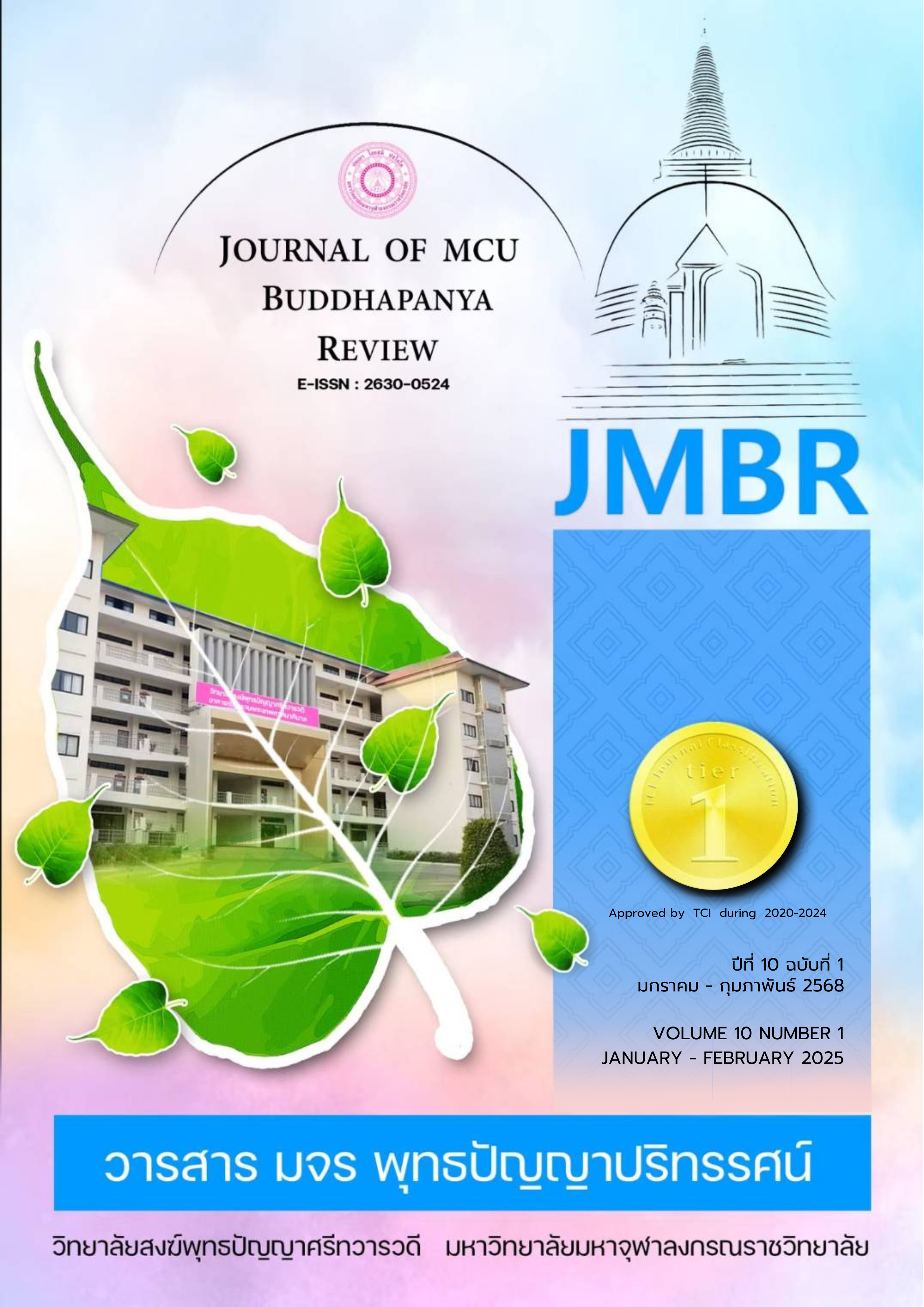The Effect of Problem-based Learning on Students’ Learning Motivation in English Reading for Junior High School Students
Keywords:
Learning motivation, Problem-based Learning, Junior High School StudentsAbstract
This Article aimed to study: (1) Study the definition, components of learning motivation for students in junior high school. 2) Development of the problem-based learning model to enhance students’ learning motivation in junior high school. 3) Assess the effectiveness of the problem-based learning model for enhancing students’ learning motivation in junior high school.
The sample was from 6 classes of Grade 8, with Class 4 as the experimental class (EC), and Class 5 as the controlled class (CC). 66 students from these two classes were at the age of 13-14, with similar educational experience. In the selection of schools and grades, the researchers adopted the method of multi-stage random sampling. The researcher adopted a simple random method in the process of selecting two classes as the experimental group and the control group respectively. The instrument for collecting data was developing questionnaires, and testing, modifying the questionnaire through project analysis, validity, reliability. Analysis data by Descriptive statistics and Content Analysis. The data was analyzed using SPSS statistical software package. A paired t test was to use compare the results of the two questionnaires. Pearson's correlation coefficient was performed to determine the relationship among the students' learning motivation and Problem-based Learning. In addition, descriptive statistics were used to analyze the students' responses to the questionnaire. The research results were found as follows: 1) It indicates that girls' motivation for English reading is higher than that of boys. 2) PBL learning model has a positive impact on students' learning motivation in English reading. 3) PBL learning model has positive effects on Activation, persistence, and intensity of students' learning motivation in English reading. Persistent is statistically correlated with activation and Intensity. The higher the activation and Intensity, the higher the persistence.
References
Afzal Hasan, Ali Imran, Aslam Khan Muhammad, Hamid Kashif, (2010), A Study of University Students’ Motivation and Its Relationship with Their Academic Performance, International Journal of Business and Management, Vol 5, Issue 4, Page(s) 80-88
Ali, S. S. (2019). Problem based learning: A student-centered approach. English language teaching, 12(5), 73-78.
Atkinson, J. W. and Raynor, J. O. (1974). Motivation and Achievement. New York: Winston/Wiley.
Bandura A. 1990. Self-regulation of motivation through anticipatory and self-reactive mechanisms. Nebr. Symp. Motiv. 36: 69–164
Barrows, H. S., & Tamblyn, R. M. (1980). Problem-based learning: An approach to medical education (Vol. 1). Springer Publishing Company.
Barrows, H.S. Problem-Based Learning in Medicine and Beyond: A Brief Overview [J]. New Direction for Teaching and Learning 1996(6): 3-12.
Barrows, T. S. (1988). Native language, English proficiency, and the structure of the Test of English as a Foreign Language. ETS Research Report Series, 1988(1), i-36.
Brophy, J. (2004). Motivating students to learn, second edition. New Jersey London: Lawrence Erlbaum Associates Publishers Mahwah.
Brown, A. L., & Cocking, R. R. (2000). How people learn (Vol. 11). Washington, DC: National academy press.
Collins, A., Brown, J. S., & Newman, S. E. (1988). Cognitive apprenticeship: Teaching the craft of reading, writing and mathematics. Thinking: The journal of philosophy for children, 8(1), 2-10.
Crookes, G. & Schmidt, R.W. (1991), ‘Motivation: reopening the research agenda’, Language Learning, 41, 4: 469-512.
David, T. & Barbara, M. Problem-based learning: Where Are We Now? [J]. Medical Teacher, 2008:30(8):742-763.
Deci, E., Ryan, R. (1985). Intrinsic motivation and self-determination in human behavior, New York: Plenum Press.
Gardner, R. (1985). Social Psychology and Second Language Learning: The Role of Attitude and Motivation. London: Edward Arnold.
Gardner, R.C.&Lambert, W.E. (1972). Attitudes and motivation in second language learning.Rowley, MA: Newbury House.
Harmer, J. (1991). ‘The practice of English Language Teaching’. London: Longman, 371.
Kim Kyong-Jee and W. Frick Theodore, (2011), Changes in Student Motivation during Online Learning, Journal of Educational Computing Research, Vol 44, Page(s) 1 – 23
Maslow, A. (1987). Motivation and personality’. 3rd ed., revised by R. Frager, J. Fadiman, C. McReynolds, & R.Cox ed. New York: Harper & Row.
Maudsley, G. Do we all mean the same thing by “Problem-Based Learning”? A review of the concepts and a formulation of the ground rules[J]. Academic Medicine. 1999, (2): 178-85.
Paris, S. G., Lipson, M. Y., & Wixson, K. (1983). Becoming a strategic reader. Contemporary Educational Psycology, 8, 293-316.
Paul, Eggen., & Kauchak, Don. (2005). Educational Psychology: Windows on Classroom, Shangxi: Shangxi Normal University Press.
Paul, Eggen., & Kauchak, Don. (2005). Educational Psychology: Windows on Classroom, Shangxi: Shangxi Normal University Press.
Pintrich, P. and Schunk, D. (1996). ‘Motivation in Education: Theory, Research & Applications’, Ch. 3. Englewood Cliffs, NJ: Prentice-Hall.
Prince, M. J., & Felder, R. M. (2006). Inductive teaching and learning methods: Definitions, comparisons, and research bases. Journal of engineering education, 95(2), 123-138.
Reeve, J. (1993). The face of interest. Motivation and Emotion, 1, 353-375.
Rehman, A., & Haider, K. (2013). The impact of motivation on learning of secondary school students in Karachi: An analytical study. Educational Research International, 2 (2), 139-147.
Sandhu, N., Hussain, J., & Matlay, H. (2012). Barriers to finance experienced by female owner/managers of marginal farms in India. Journal of Small Business and Enterprise Development, 19(4), 640-655.
Santrock, J. (2007). Child development. New York. McGrow
Schiefele, U., & Rheinberg, F. (1997). Motivation and knowledge acquisition: Searching for mediating processes. Advances in motivation and achievement, 10, 251-301.
Schmidt, H. G. (1983). Problem‐based learning: Rationale and description. Medical education, 17(1), 11-16.
Silver, C. E. (2004). Problem-based learning: What and how do students learn?. Educational psychology review, 16, 235-266.
Winkel, W. S. (2004). Psikologi pengajaran (Teaching psychology). Jakarta, Indonesia: PT. Grasindo.
Woods, D. R., & Learning, P. B. (2000). Helping your students gain the most from PBL. Problem-based learning: Educational innovation across disciplines. Singapore: Temasek Centre for Problem-based Learning.
Downloads
Published
How to Cite
Issue
Section
License
Copyright (c) 2025 Journal of MCU Buddhapanya Review

This work is licensed under a Creative Commons Attribution-NonCommercial-NoDerivatives 4.0 International License.



